Working with People: Leadership, Management and HR at Clarks
VerifiedAdded on 2024/05/29
|25
|4301
|428
Report
AI Summary
This report explores various aspects of working with and leading people, focusing on recruitment and selection processes, leadership and management differences, teamwork benefits, and HR practices within the context of a case study on Clarks. It covers essential documentation for staff recruitment, the impact of legal and ethical considerations, and potential reasons for ineffective recruitment practices. The report also examines the skills and attributes necessary for effective leadership, contrasting leadership and management styles, and suggesting ways to motivate employees using Maslow's hierarchy of needs. Furthermore, it discusses the benefits of teamwork, factors involved in planning and monitoring work performance, and the assessment of development needs for a store manager at Clarks, ultimately evaluating the success of the assessment process. Desklib offers similar solved assignments for students.
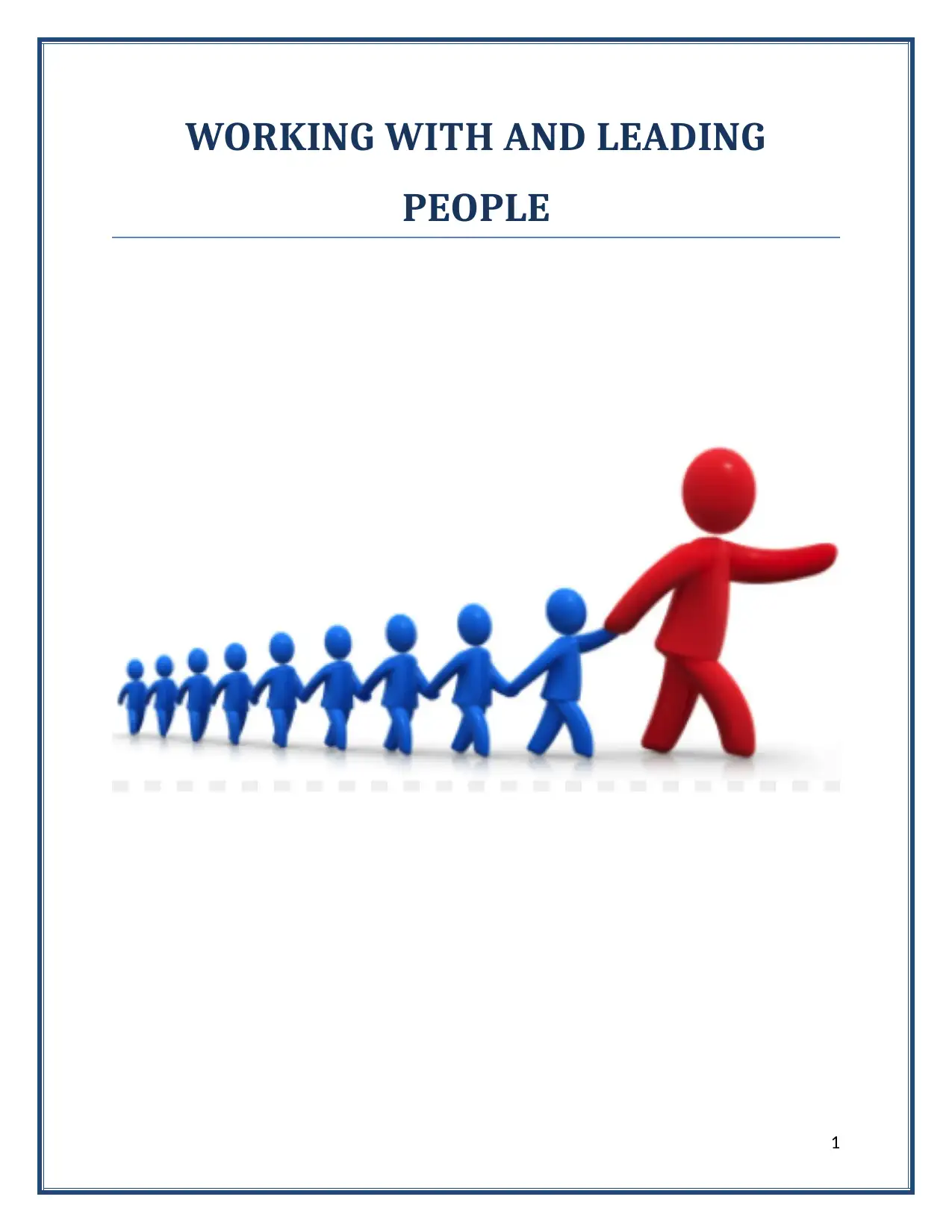
WORKING WITH AND LEADING
PEOPLE
1
PEOPLE
1
Paraphrase This Document
Need a fresh take? Get an instant paraphrase of this document with our AI Paraphraser
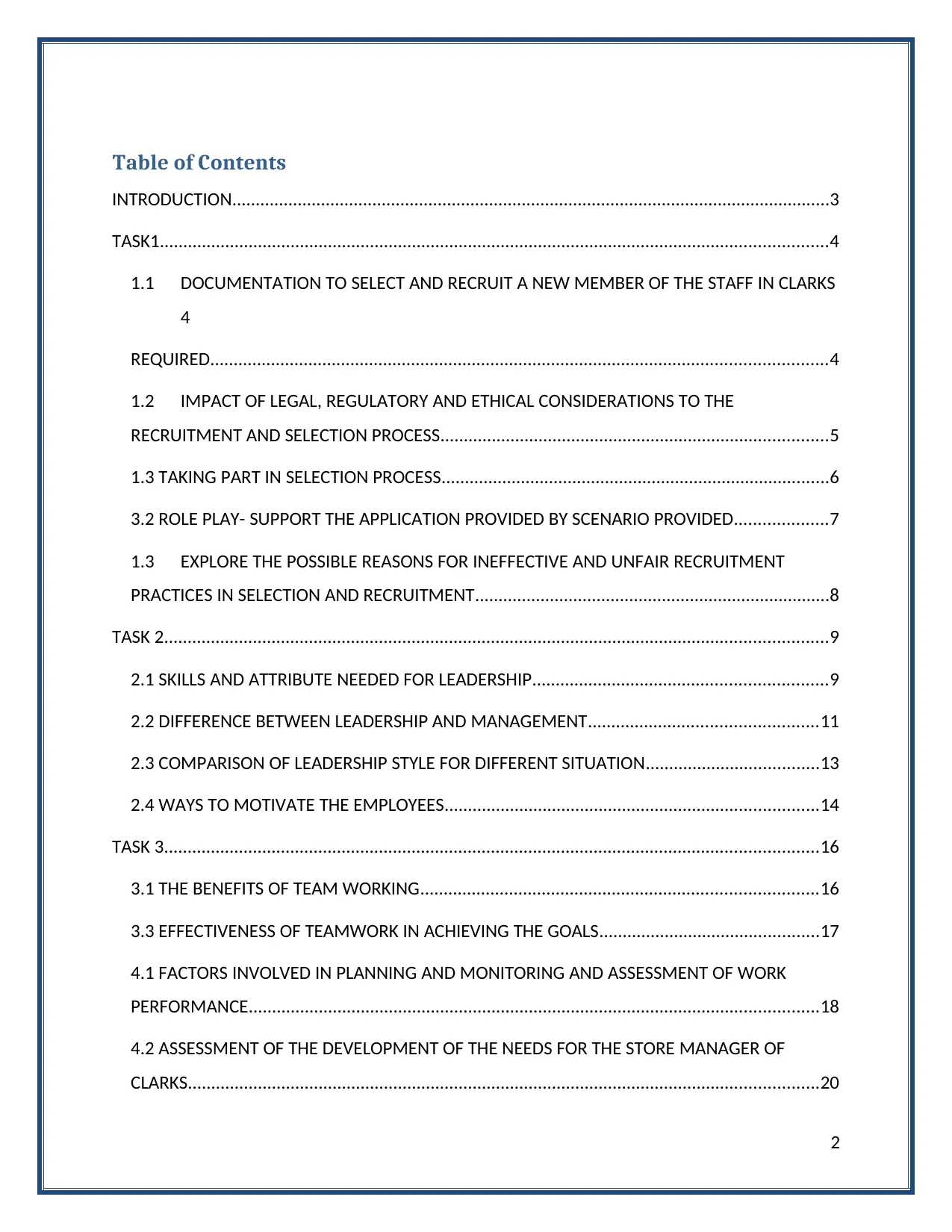
Table of Contents
INTRODUCTION................................................................................................................................3
TASK1...............................................................................................................................................4
1.1 DOCUMENTATION TO SELECT AND RECRUIT A NEW MEMBER OF THE STAFF IN CLARKS
4
REQUIRED....................................................................................................................................4
1.2 IMPACT OF LEGAL, REGULATORY AND ETHICAL CONSIDERATIONS TO THE
RECRUITMENT AND SELECTION PROCESS...................................................................................5
1.3 TAKING PART IN SELECTION PROCESS...................................................................................6
3.2 ROLE PLAY- SUPPORT THE APPLICATION PROVIDED BY SCENARIO PROVIDED....................7
1.3 EXPLORE THE POSSIBLE REASONS FOR INEFFECTIVE AND UNFAIR RECRUITMENT
PRACTICES IN SELECTION AND RECRUITMENT............................................................................8
TASK 2..............................................................................................................................................9
2.1 SKILLS AND ATTRIBUTE NEEDED FOR LEADERSHIP...............................................................9
2.2 DIFFERENCE BETWEEN LEADERSHIP AND MANAGEMENT.................................................11
2.3 COMPARISON OF LEADERSHIP STYLE FOR DIFFERENT SITUATION.....................................13
2.4 WAYS TO MOTIVATE THE EMPLOYEES................................................................................14
TASK 3............................................................................................................................................16
3.1 THE BENEFITS OF TEAM WORKING.....................................................................................16
3.3 EFFECTIVENESS OF TEAMWORK IN ACHIEVING THE GOALS...............................................17
4.1 FACTORS INVOLVED IN PLANNING AND MONITORING AND ASSESSMENT OF WORK
PERFORMANCE..........................................................................................................................18
4.2 ASSESSMENT OF THE DEVELOPMENT OF THE NEEDS FOR THE STORE MANAGER OF
CLARKS.......................................................................................................................................20
2
INTRODUCTION................................................................................................................................3
TASK1...............................................................................................................................................4
1.1 DOCUMENTATION TO SELECT AND RECRUIT A NEW MEMBER OF THE STAFF IN CLARKS
4
REQUIRED....................................................................................................................................4
1.2 IMPACT OF LEGAL, REGULATORY AND ETHICAL CONSIDERATIONS TO THE
RECRUITMENT AND SELECTION PROCESS...................................................................................5
1.3 TAKING PART IN SELECTION PROCESS...................................................................................6
3.2 ROLE PLAY- SUPPORT THE APPLICATION PROVIDED BY SCENARIO PROVIDED....................7
1.3 EXPLORE THE POSSIBLE REASONS FOR INEFFECTIVE AND UNFAIR RECRUITMENT
PRACTICES IN SELECTION AND RECRUITMENT............................................................................8
TASK 2..............................................................................................................................................9
2.1 SKILLS AND ATTRIBUTE NEEDED FOR LEADERSHIP...............................................................9
2.2 DIFFERENCE BETWEEN LEADERSHIP AND MANAGEMENT.................................................11
2.3 COMPARISON OF LEADERSHIP STYLE FOR DIFFERENT SITUATION.....................................13
2.4 WAYS TO MOTIVATE THE EMPLOYEES................................................................................14
TASK 3............................................................................................................................................16
3.1 THE BENEFITS OF TEAM WORKING.....................................................................................16
3.3 EFFECTIVENESS OF TEAMWORK IN ACHIEVING THE GOALS...............................................17
4.1 FACTORS INVOLVED IN PLANNING AND MONITORING AND ASSESSMENT OF WORK
PERFORMANCE..........................................................................................................................18
4.2 ASSESSMENT OF THE DEVELOPMENT OF THE NEEDS FOR THE STORE MANAGER OF
CLARKS.......................................................................................................................................20
2
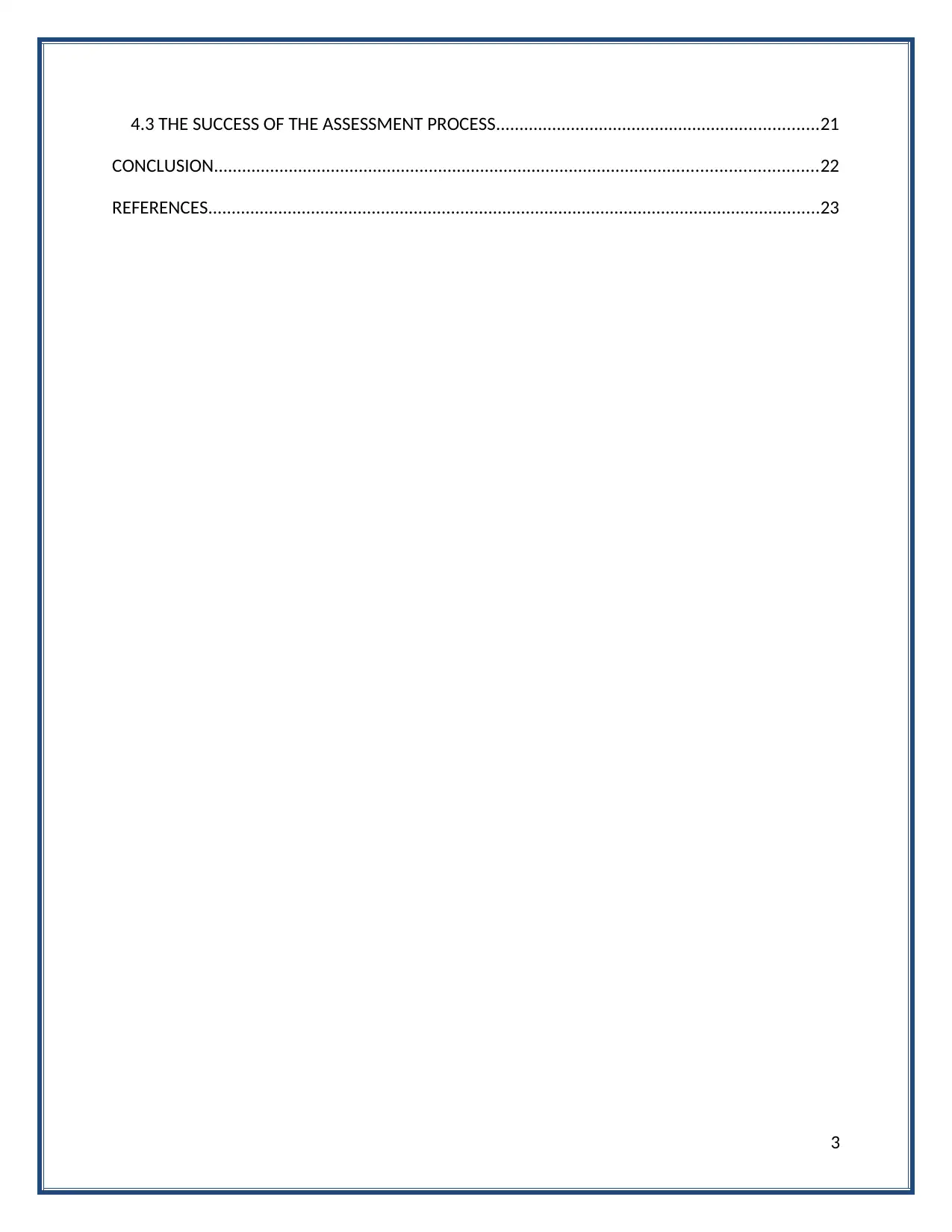
4.3 THE SUCCESS OF THE ASSESSMENT PROCESS.....................................................................21
CONCLUSION.................................................................................................................................22
REFERENCES...................................................................................................................................23
3
CONCLUSION.................................................................................................................................22
REFERENCES...................................................................................................................................23
3
⊘ This is a preview!⊘
Do you want full access?
Subscribe today to unlock all pages.

Trusted by 1+ million students worldwide
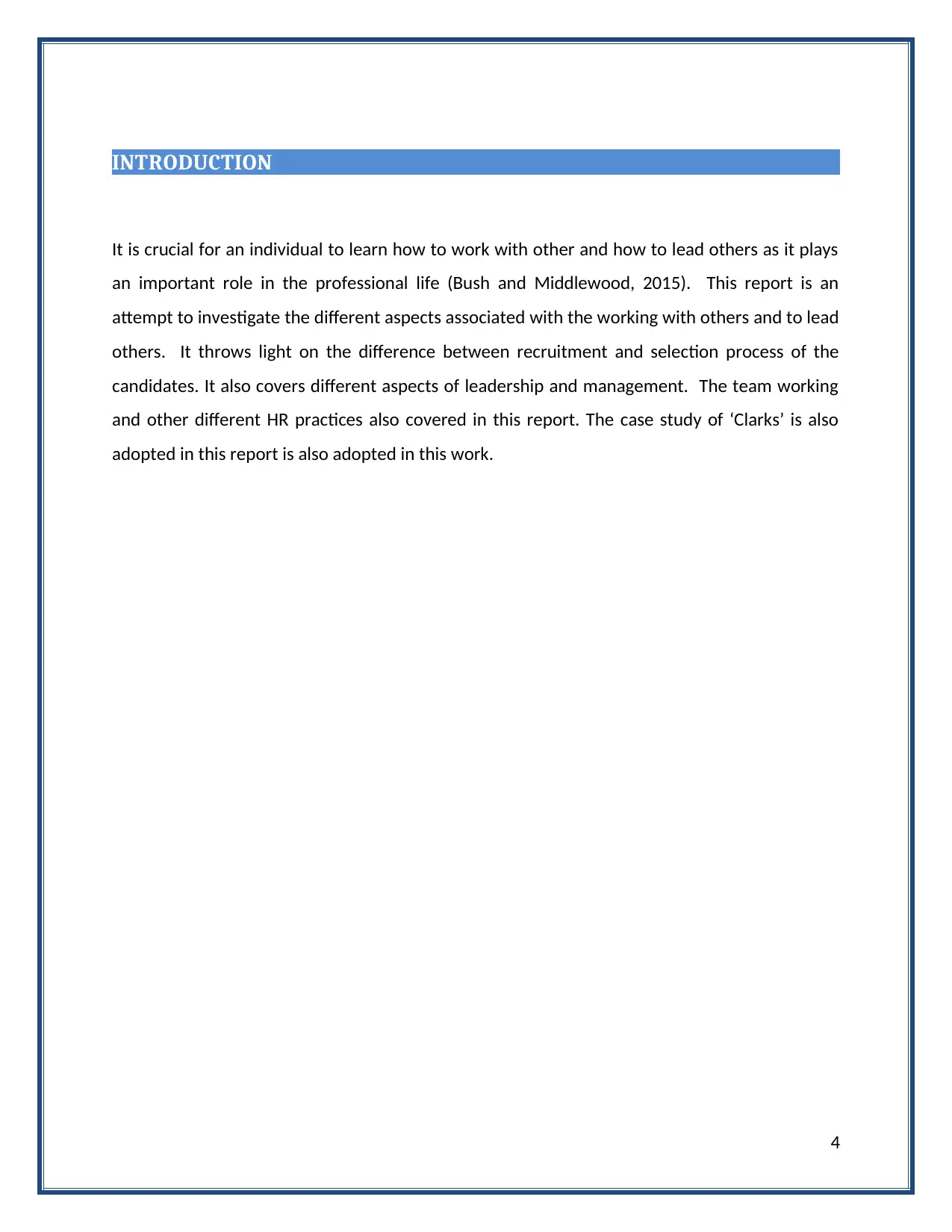
INTRODUCTION
It is crucial for an individual to learn how to work with other and how to lead others as it plays
an important role in the professional life (Bush and Middlewood, 2015). This report is an
attempt to investigate the different aspects associated with the working with others and to lead
others. It throws light on the difference between recruitment and selection process of the
candidates. It also covers different aspects of leadership and management. The team working
and other different HR practices also covered in this report. The case study of ‘Clarks’ is also
adopted in this report is also adopted in this work.
4
It is crucial for an individual to learn how to work with other and how to lead others as it plays
an important role in the professional life (Bush and Middlewood, 2015). This report is an
attempt to investigate the different aspects associated with the working with others and to lead
others. It throws light on the difference between recruitment and selection process of the
candidates. It also covers different aspects of leadership and management. The team working
and other different HR practices also covered in this report. The case study of ‘Clarks’ is also
adopted in this report is also adopted in this work.
4
Paraphrase This Document
Need a fresh take? Get an instant paraphrase of this document with our AI Paraphraser
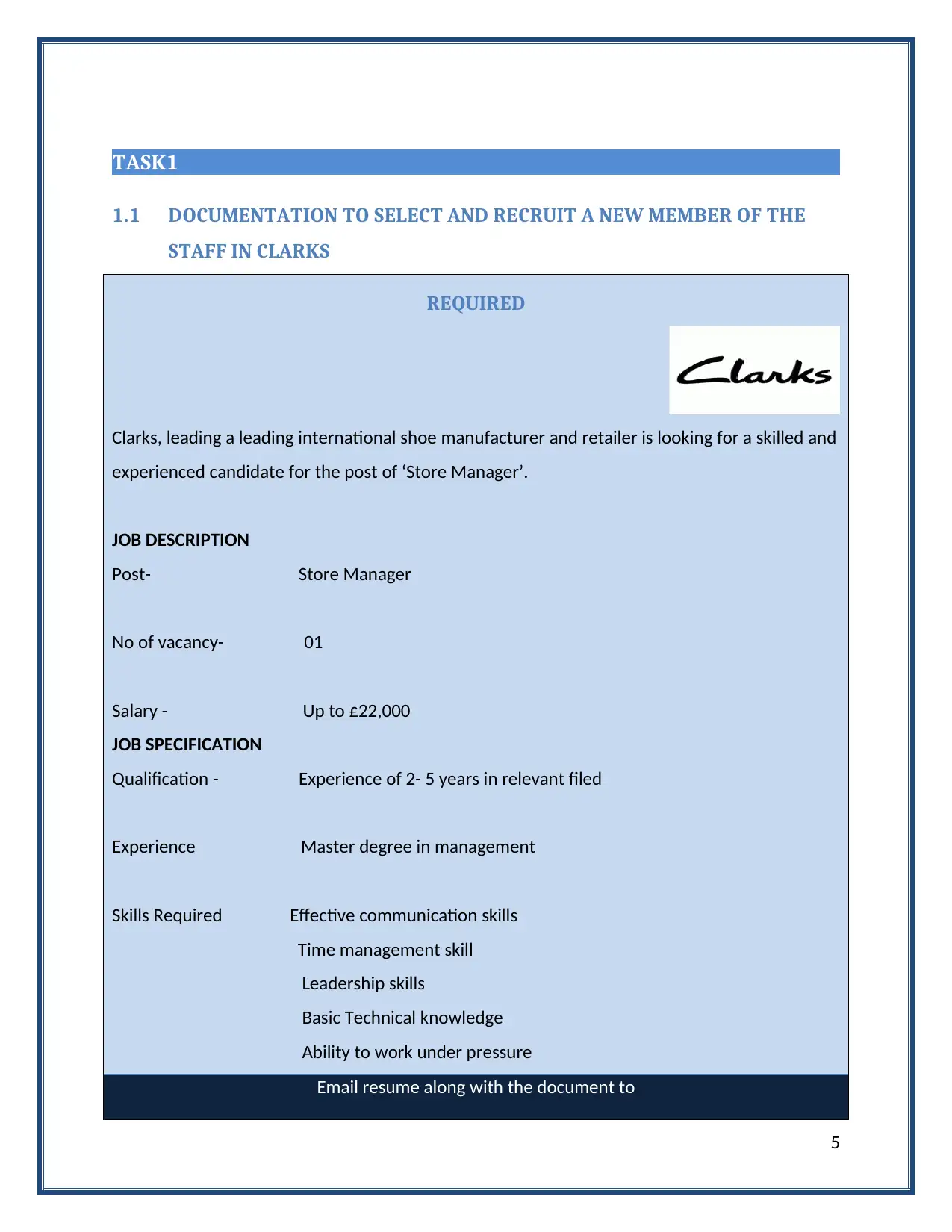
TASK1
1.1 DOCUMENTATION TO SELECT AND RECRUIT A NEW MEMBER OF THE
STAFF IN CLARKS
REQUIRED
Clarks, leading a leading international shoe manufacturer and retailer is looking for a skilled and
experienced candidate for the post of ‘Store Manager’.
JOB DESCRIPTION
Post- Store Manager
No of vacancy- 01
Salary - Up to £22,000
JOB SPECIFICATION
Qualification - Experience of 2- 5 years in relevant filed
Experience Master degree in management
Skills Required Effective communication skills
Time management skill
Leadership skills
Basic Technical knowledge
Ability to work under pressure
Email resume along with the document to
5
1.1 DOCUMENTATION TO SELECT AND RECRUIT A NEW MEMBER OF THE
STAFF IN CLARKS
REQUIRED
Clarks, leading a leading international shoe manufacturer and retailer is looking for a skilled and
experienced candidate for the post of ‘Store Manager’.
JOB DESCRIPTION
Post- Store Manager
No of vacancy- 01
Salary - Up to £22,000
JOB SPECIFICATION
Qualification - Experience of 2- 5 years in relevant filed
Experience Master degree in management
Skills Required Effective communication skills
Time management skill
Leadership skills
Basic Technical knowledge
Ability to work under pressure
Email resume along with the document to
5

HR.support@clarks.com
1.2 IMPACT OF LEGAL, REGULATORY AND ETHICAL CONSIDERATIONS TO
THE RECRUITMENT AND SELECTION PROCESS
Legal, regulatory and ethical factors influence the recruitment and selection process of a
company. Clarks should consider the different all the legal, regulatory and ethical consideration
in order to recruit and select the suitable candidate (Taylor, 2014).
The legal and regulatory focus possesses a great impact on the recruitment and selection
process. Equality Act, 2010, Sex Discrimination Act 2010, Employment Equality regulation 2013
is the key legislation which should be considered by clerks to recruit and select the employees.
These acts ensure that a company recruit the employees without any kind of discrimination and
treat them fairly.
Ethical factors also affect greatly to the recruitment and selection process of a company. a
company should take care of ethics while advertising, interviewing and conducting other such
activities. A company should not discriminate the employees on the basis of different factors
such as nationality, culture, custom, tradition, caste etc.
6
1.2 IMPACT OF LEGAL, REGULATORY AND ETHICAL CONSIDERATIONS TO
THE RECRUITMENT AND SELECTION PROCESS
Legal, regulatory and ethical factors influence the recruitment and selection process of a
company. Clarks should consider the different all the legal, regulatory and ethical consideration
in order to recruit and select the suitable candidate (Taylor, 2014).
The legal and regulatory focus possesses a great impact on the recruitment and selection
process. Equality Act, 2010, Sex Discrimination Act 2010, Employment Equality regulation 2013
is the key legislation which should be considered by clerks to recruit and select the employees.
These acts ensure that a company recruit the employees without any kind of discrimination and
treat them fairly.
Ethical factors also affect greatly to the recruitment and selection process of a company. a
company should take care of ethics while advertising, interviewing and conducting other such
activities. A company should not discriminate the employees on the basis of different factors
such as nationality, culture, custom, tradition, caste etc.
6
⊘ This is a preview!⊘
Do you want full access?
Subscribe today to unlock all pages.

Trusted by 1+ million students worldwide
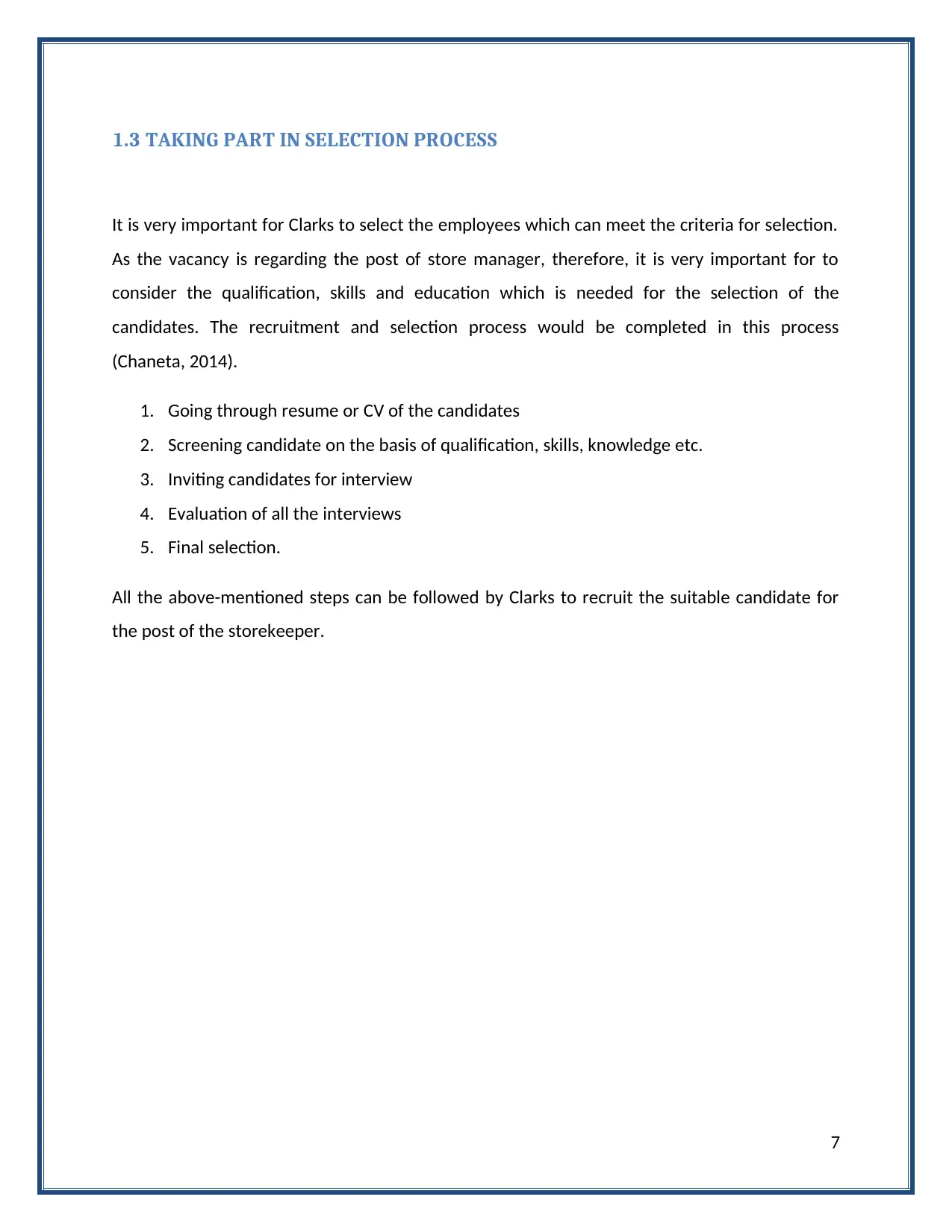
1.3 TAKING PART IN SELECTION PROCESS
It is very important for Clarks to select the employees which can meet the criteria for selection.
As the vacancy is regarding the post of store manager, therefore, it is very important for to
consider the qualification, skills and education which is needed for the selection of the
candidates. The recruitment and selection process would be completed in this process
(Chaneta, 2014).
1. Going through resume or CV of the candidates
2. Screening candidate on the basis of qualification, skills, knowledge etc.
3. Inviting candidates for interview
4. Evaluation of all the interviews
5. Final selection.
All the above-mentioned steps can be followed by Clarks to recruit the suitable candidate for
the post of the storekeeper.
7
It is very important for Clarks to select the employees which can meet the criteria for selection.
As the vacancy is regarding the post of store manager, therefore, it is very important for to
consider the qualification, skills and education which is needed for the selection of the
candidates. The recruitment and selection process would be completed in this process
(Chaneta, 2014).
1. Going through resume or CV of the candidates
2. Screening candidate on the basis of qualification, skills, knowledge etc.
3. Inviting candidates for interview
4. Evaluation of all the interviews
5. Final selection.
All the above-mentioned steps can be followed by Clarks to recruit the suitable candidate for
the post of the storekeeper.
7
Paraphrase This Document
Need a fresh take? Get an instant paraphrase of this document with our AI Paraphraser
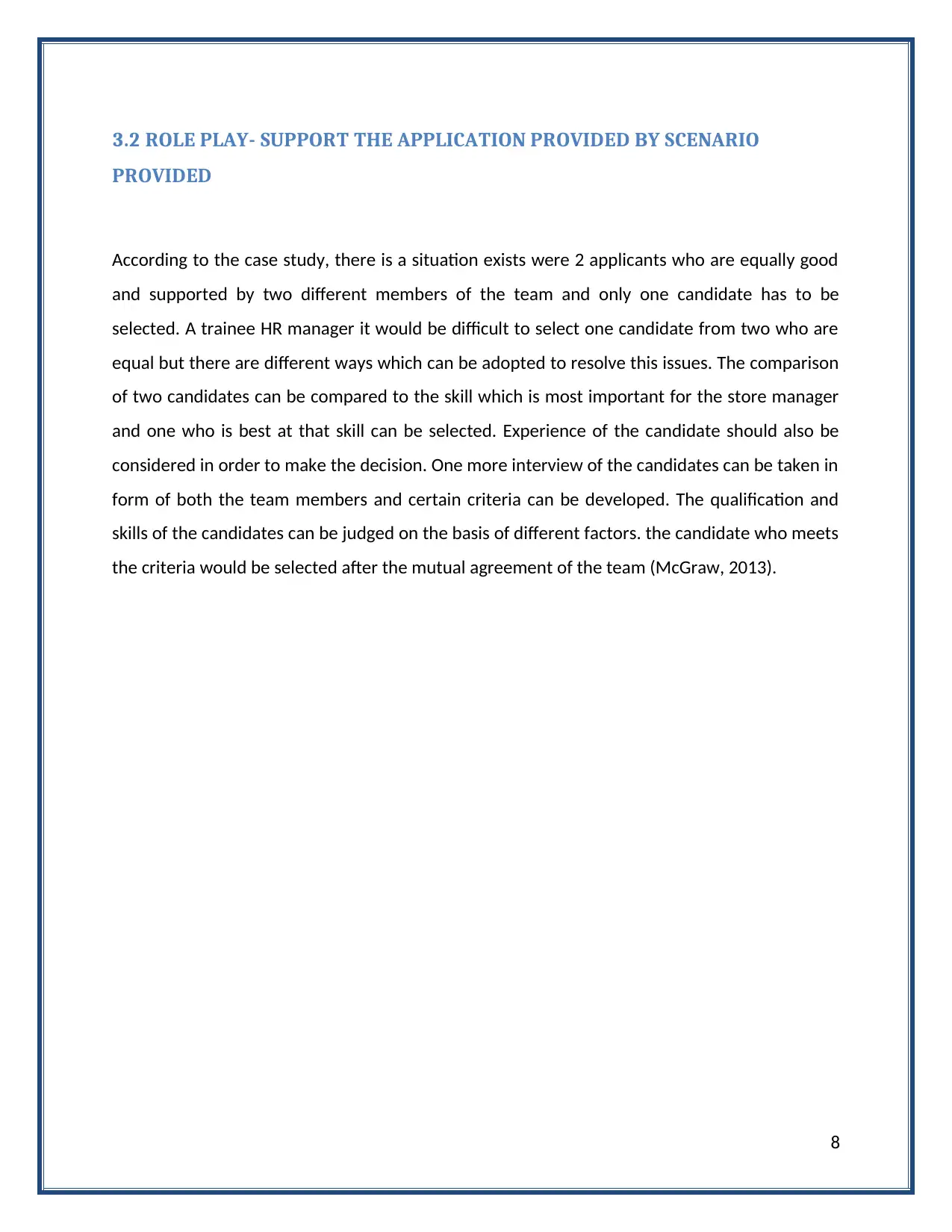
3.2 ROLE PLAY- SUPPORT THE APPLICATION PROVIDED BY SCENARIO
PROVIDED
According to the case study, there is a situation exists were 2 applicants who are equally good
and supported by two different members of the team and only one candidate has to be
selected. A trainee HR manager it would be difficult to select one candidate from two who are
equal but there are different ways which can be adopted to resolve this issues. The comparison
of two candidates can be compared to the skill which is most important for the store manager
and one who is best at that skill can be selected. Experience of the candidate should also be
considered in order to make the decision. One more interview of the candidates can be taken in
form of both the team members and certain criteria can be developed. The qualification and
skills of the candidates can be judged on the basis of different factors. the candidate who meets
the criteria would be selected after the mutual agreement of the team (McGraw, 2013).
8
PROVIDED
According to the case study, there is a situation exists were 2 applicants who are equally good
and supported by two different members of the team and only one candidate has to be
selected. A trainee HR manager it would be difficult to select one candidate from two who are
equal but there are different ways which can be adopted to resolve this issues. The comparison
of two candidates can be compared to the skill which is most important for the store manager
and one who is best at that skill can be selected. Experience of the candidate should also be
considered in order to make the decision. One more interview of the candidates can be taken in
form of both the team members and certain criteria can be developed. The qualification and
skills of the candidates can be judged on the basis of different factors. the candidate who meets
the criteria would be selected after the mutual agreement of the team (McGraw, 2013).
8
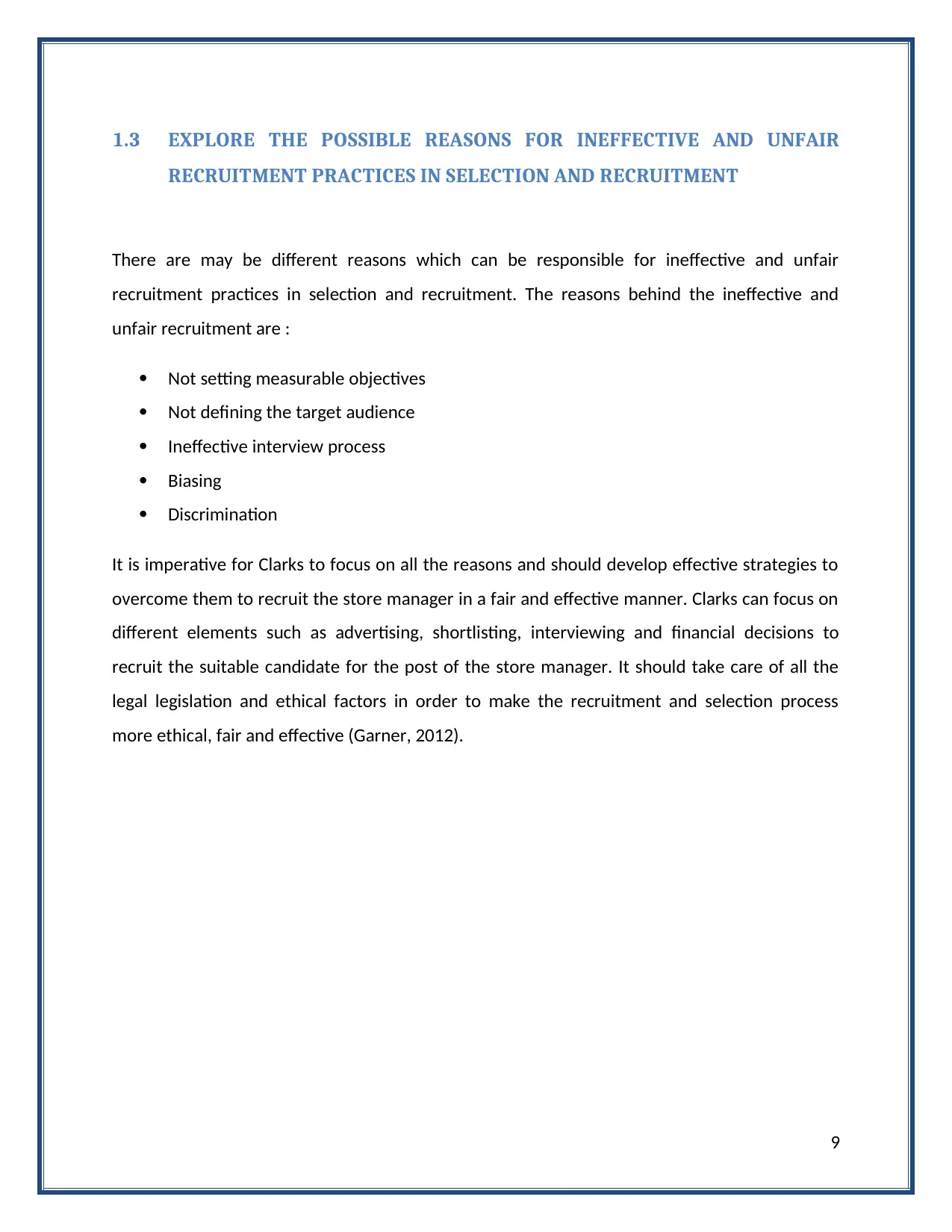
1.3 EXPLORE THE POSSIBLE REASONS FOR INEFFECTIVE AND UNFAIR
RECRUITMENT PRACTICES IN SELECTION AND RECRUITMENT
There are may be different reasons which can be responsible for ineffective and unfair
recruitment practices in selection and recruitment. The reasons behind the ineffective and
unfair recruitment are :
Not setting measurable objectives
Not defining the target audience
Ineffective interview process
Biasing
Discrimination
It is imperative for Clarks to focus on all the reasons and should develop effective strategies to
overcome them to recruit the store manager in a fair and effective manner. Clarks can focus on
different elements such as advertising, shortlisting, interviewing and financial decisions to
recruit the suitable candidate for the post of the store manager. It should take care of all the
legal legislation and ethical factors in order to make the recruitment and selection process
more ethical, fair and effective (Garner, 2012).
9
RECRUITMENT PRACTICES IN SELECTION AND RECRUITMENT
There are may be different reasons which can be responsible for ineffective and unfair
recruitment practices in selection and recruitment. The reasons behind the ineffective and
unfair recruitment are :
Not setting measurable objectives
Not defining the target audience
Ineffective interview process
Biasing
Discrimination
It is imperative for Clarks to focus on all the reasons and should develop effective strategies to
overcome them to recruit the store manager in a fair and effective manner. Clarks can focus on
different elements such as advertising, shortlisting, interviewing and financial decisions to
recruit the suitable candidate for the post of the store manager. It should take care of all the
legal legislation and ethical factors in order to make the recruitment and selection process
more ethical, fair and effective (Garner, 2012).
9
⊘ This is a preview!⊘
Do you want full access?
Subscribe today to unlock all pages.

Trusted by 1+ million students worldwide
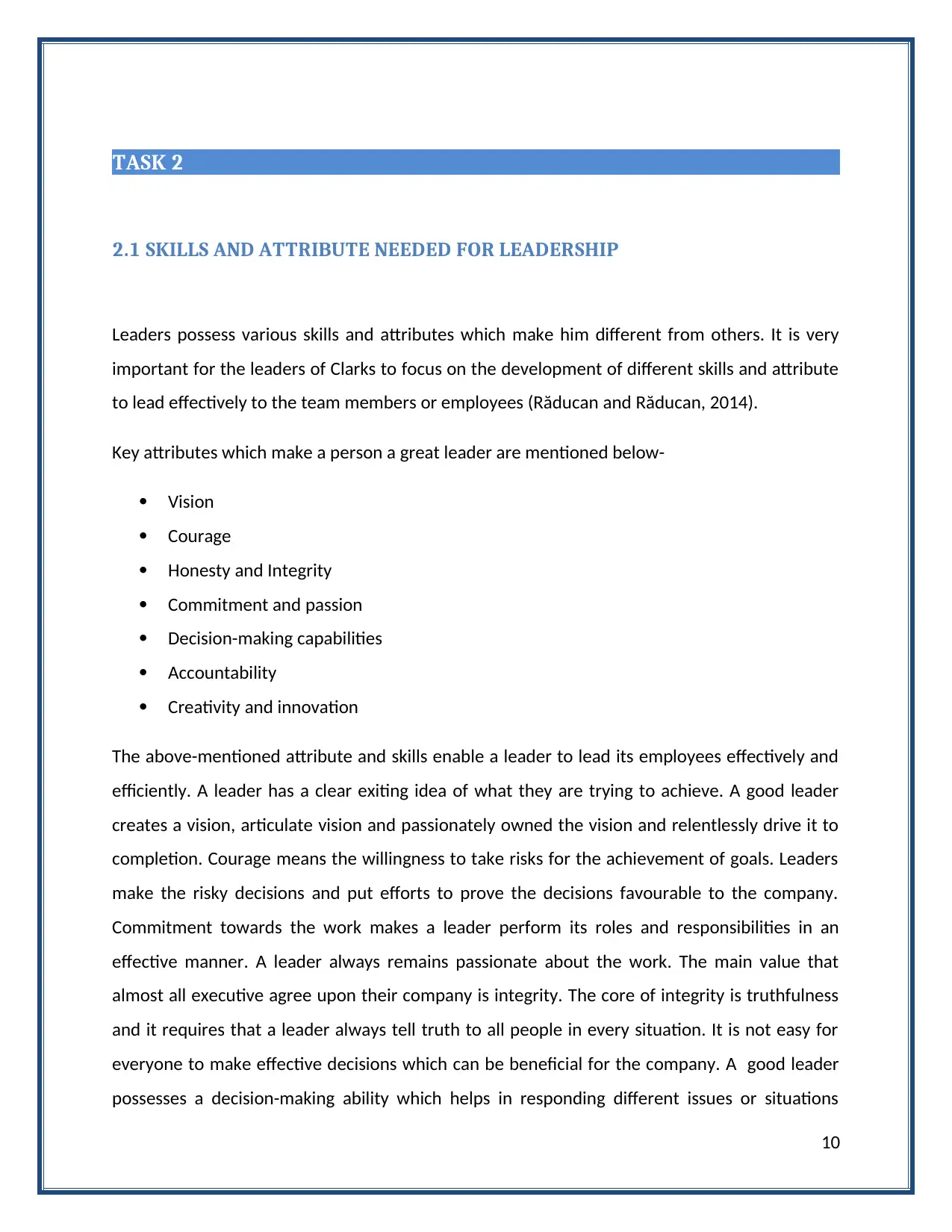
TASK 2
2.1 SKILLS AND ATTRIBUTE NEEDED FOR LEADERSHIP
Leaders possess various skills and attributes which make him different from others. It is very
important for the leaders of Clarks to focus on the development of different skills and attribute
to lead effectively to the team members or employees (Răducan and Răducan, 2014).
Key attributes which make a person a great leader are mentioned below-
Vision
Courage
Honesty and Integrity
Commitment and passion
Decision-making capabilities
Accountability
Creativity and innovation
The above-mentioned attribute and skills enable a leader to lead its employees effectively and
efficiently. A leader has a clear exiting idea of what they are trying to achieve. A good leader
creates a vision, articulate vision and passionately owned the vision and relentlessly drive it to
completion. Courage means the willingness to take risks for the achievement of goals. Leaders
make the risky decisions and put efforts to prove the decisions favourable to the company.
Commitment towards the work makes a leader perform its roles and responsibilities in an
effective manner. A leader always remains passionate about the work. The main value that
almost all executive agree upon their company is integrity. The core of integrity is truthfulness
and it requires that a leader always tell truth to all people in every situation. It is not easy for
everyone to make effective decisions which can be beneficial for the company. A good leader
possesses a decision-making ability which helps in responding different issues or situations
10
2.1 SKILLS AND ATTRIBUTE NEEDED FOR LEADERSHIP
Leaders possess various skills and attributes which make him different from others. It is very
important for the leaders of Clarks to focus on the development of different skills and attribute
to lead effectively to the team members or employees (Răducan and Răducan, 2014).
Key attributes which make a person a great leader are mentioned below-
Vision
Courage
Honesty and Integrity
Commitment and passion
Decision-making capabilities
Accountability
Creativity and innovation
The above-mentioned attribute and skills enable a leader to lead its employees effectively and
efficiently. A leader has a clear exiting idea of what they are trying to achieve. A good leader
creates a vision, articulate vision and passionately owned the vision and relentlessly drive it to
completion. Courage means the willingness to take risks for the achievement of goals. Leaders
make the risky decisions and put efforts to prove the decisions favourable to the company.
Commitment towards the work makes a leader perform its roles and responsibilities in an
effective manner. A leader always remains passionate about the work. The main value that
almost all executive agree upon their company is integrity. The core of integrity is truthfulness
and it requires that a leader always tell truth to all people in every situation. It is not easy for
everyone to make effective decisions which can be beneficial for the company. A good leader
possesses a decision-making ability which helps in responding different issues or situations
10
Paraphrase This Document
Need a fresh take? Get an instant paraphrase of this document with our AI Paraphraser
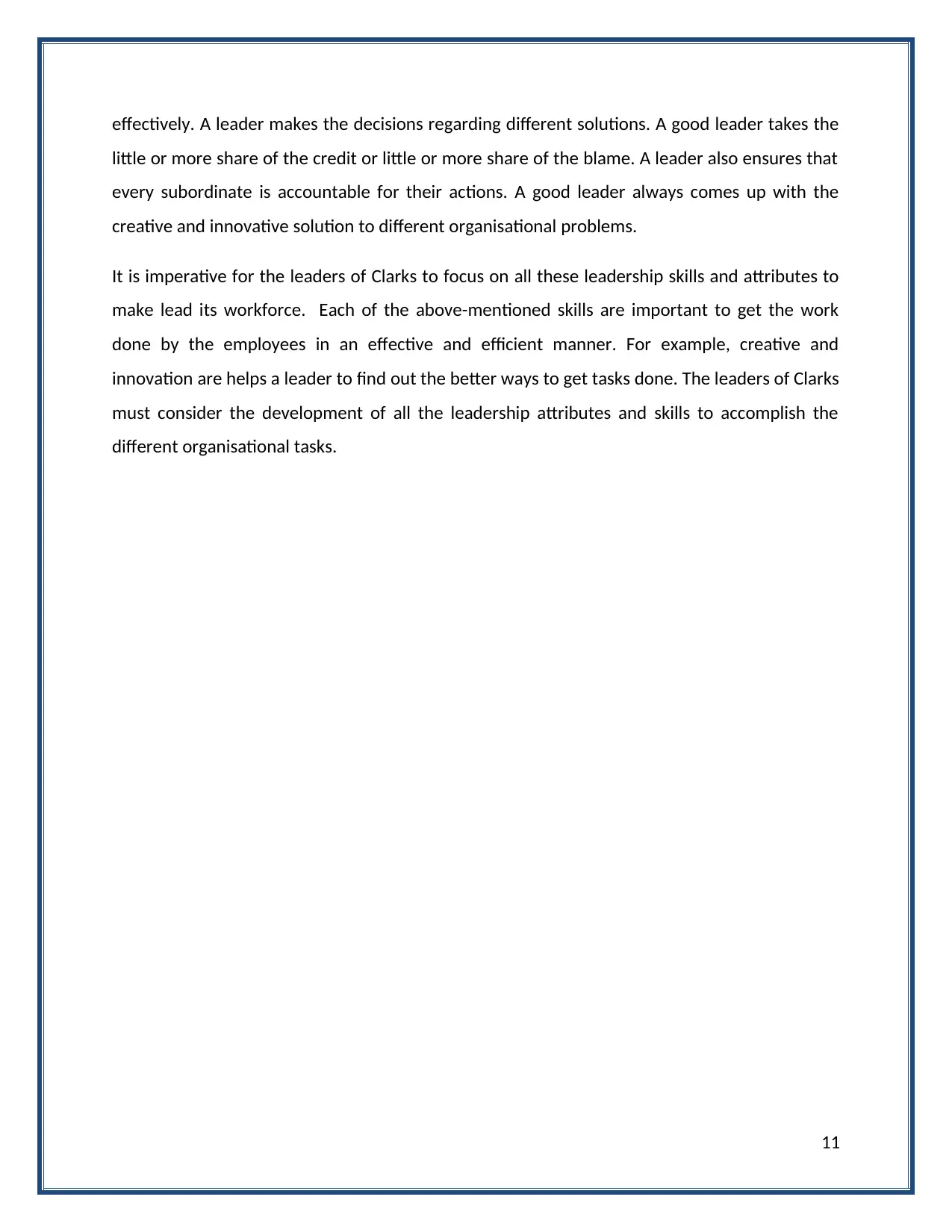
effectively. A leader makes the decisions regarding different solutions. A good leader takes the
little or more share of the credit or little or more share of the blame. A leader also ensures that
every subordinate is accountable for their actions. A good leader always comes up with the
creative and innovative solution to different organisational problems.
It is imperative for the leaders of Clarks to focus on all these leadership skills and attributes to
make lead its workforce. Each of the above-mentioned skills are important to get the work
done by the employees in an effective and efficient manner. For example, creative and
innovation are helps a leader to find out the better ways to get tasks done. The leaders of Clarks
must consider the development of all the leadership attributes and skills to accomplish the
different organisational tasks.
11
little or more share of the credit or little or more share of the blame. A leader also ensures that
every subordinate is accountable for their actions. A good leader always comes up with the
creative and innovative solution to different organisational problems.
It is imperative for the leaders of Clarks to focus on all these leadership skills and attributes to
make lead its workforce. Each of the above-mentioned skills are important to get the work
done by the employees in an effective and efficient manner. For example, creative and
innovation are helps a leader to find out the better ways to get tasks done. The leaders of Clarks
must consider the development of all the leadership attributes and skills to accomplish the
different organisational tasks.
11

2.2 DIFFERENCE BETWEEN LEADERSHIP AND MANAGEMENT
Leadership and management both are important elements that contribute significantly to the
success of an organisation. Leadership refers to the action of leading a group of people or the
ability to do this.in simple words it is the art of motivating employees to perform their roles and
responsibilities more effectively and efficiently. Management refers to the process of dealing
with controlling things and people. It is important for Clarks to focus on developing effective
management as well as leadership (Bolden, 2016).
Table1: Difference between leadership and management
12
Leadership and management both are important elements that contribute significantly to the
success of an organisation. Leadership refers to the action of leading a group of people or the
ability to do this.in simple words it is the art of motivating employees to perform their roles and
responsibilities more effectively and efficiently. Management refers to the process of dealing
with controlling things and people. It is important for Clarks to focus on developing effective
management as well as leadership (Bolden, 2016).
Table1: Difference between leadership and management
12
⊘ This is a preview!⊘
Do you want full access?
Subscribe today to unlock all pages.

Trusted by 1+ million students worldwide
1 out of 25
Related Documents
Your All-in-One AI-Powered Toolkit for Academic Success.
+13062052269
info@desklib.com
Available 24*7 on WhatsApp / Email
![[object Object]](/_next/static/media/star-bottom.7253800d.svg)
Unlock your academic potential
Copyright © 2020–2025 A2Z Services. All Rights Reserved. Developed and managed by ZUCOL.





